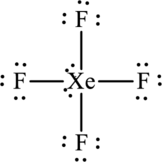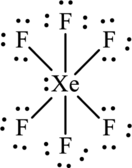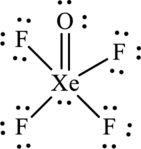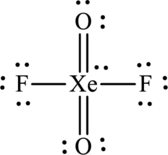
Concept explainers
Interpretation:
The Lewis structure of
Concept Introduction:
Lewis Structure: A Lewis structure shows a covalent bond as pair of electrons shared between two atoms.
Procedure to write Lewis formulas:
- 1) The symbols of the atoms that are bonded together in the molecule next to one another are arranged.
- 2) The total number of valence electrons in the molecule is calculated by adding the number of valence electrons for all the atoms in the molecules. If the species is an ion, then the charge of ion into account by adding electrons, if it is a negative ion or subtracting electrons if it is a positive ion.
- 3) A two-electron covalent bond is represented by placing a line between the atoms, which are assumed to be bonded to each other.
- 4) The remaining valence electrons as lone pairs about each atom are arranged so that the octet rule is satisfied for each other.
Formal charge (F.C): The charges that assigned to each atom in a molecule or ion by a set of arbitrary rules and don not actually represent the actual charges on the atoms are called as formal charges.
The formal charge is calculated using the formula,
The Lewis structure with zero formal charge or least separated formal charges is the preferred structure of the molecule.
Explanation of Solution
The total number of valence electrons in
Number of valence electrons in xenon=
Number of valence electrons in fluorine=
The total number of valence electrons is 22 electrons.
One xenon atom forms two bonds with fluorine that means six electrons form that bonds and the remaining sixteen are used to satisfy the octet rule of fluorine atoms.
The Lewis formula of

There would be presence of extra two electrons, since only twenty valence electrons are present.
As Xenon belongs to the fifth period, and it can expand the octet rule. The formal charge for each atom is calculated as,
Formal charge on xenon=
Formal charge on fluorine=
The total number of valence electrons in
Number of valence electrons in xenon=
Number of valence electrons in fluorine=
The total number of valence electrons is 22 electrons.
One xenon atom forms four bonds with fluorine that means eight electrons form that bonds and the remaining twenty-eight are used to satisfy the octet rule of fluorine atoms.
The Lewis formula of

There would be presence of extra four electrons, since only thirty two valence electrons are present.
As Xenon belongs to the fifth period, and it can expand the octet rule. The formal charge for each atom is calculated as,
Formal charge on xenon=
Formal charge on fluorine=
The total number of valence electrons in
Number of valence electrons in xenon=
Number of valence electrons in fluorine=
The total number of valence electrons is 50 electrons.
One xenon atom forms six bonds with fluorine that means twelve electrons form that bonds and the remaining thirty eight are used to satisfy the octet rule of fluorine atoms.
The Lewis formula of

There would be presence of extra two electrons, since only forty four valence electrons are present.
As Xenon belongs to the fifth period, and it can expand the octet rule.
The formal charge for each atom is calculated as,
Formal charge on xenon=
Formal charge on fluorine=
The total number of valence electrons in
Number of valence electrons in xenon=
Number of valence electrons in fluorine=
Number of valence electrons in oxygen=
The total number of valence electrons is 42 electrons.
One xenon atom forms four bonds with fluorine and a pi bond with oxygen that means twelve electrons form that bonds and the remaining thirty are used to satisfy the octet rule of fluorine atoms. A pi bond is used because of extra unassigned electrons.
The Lewis formula of

There would be presence of extra two electrons, since only forty valence electrons are present.
As Xenon belongs to the fifth period, and it can expand the octet rule. The formal charge for each atom is calculated as,
Formal charge on xenon=
Formal charge on fluorine=
Formal charge on oxygen=
The total number of valence electrons in
Number of valence electrons in xenon=
Number of valence electrons in fluorine=
Number of valence electrons in oxygen=
The total number of valence electrons is 34 electrons.
One xenon atom forms two bonds with fluorine and two pi bonds with oxygen that means eight electrons form that bonds and the remaining twenty-six are used to satisfy the octet rule of fluorine atoms. A pi bond is used because of extra unassigned electrons.
The Lewis formula of

As Xenon belongs to the fifth period, and it can expand the octet rule.
The formal charge for each atom is calculated as,
Formal charge on xenon=
Formal charge on fluorine=
Formal charge on oxygen=
Want to see more full solutions like this?
Chapter 7 Solutions
GENERAL CHEMISTRY ACHIEVE ACCESS W/BOOK
- Given Kp for 2 reactions. Find the Kp for the following reaction: BrCl(g)+ 1/2 I2(g) ->IBr(g) + 1/2 Cl2(g)arrow_forwardFor a certain gas-phase reaction at constant pressure, the equilibrium constant Kp is observed to double when the temperature increases from 300 K to 400 K. Calculate the enthalpy change of the reaction, Ah, using this information.arrow_forwardHydrogen bonding in water plays a key role in its physical properties. Assume that the energy required to break a hydrogen bond is approximately 8 kJ/mol. Consider a simplified two-state model where a "formed" hydrogen bond is in the ground state and a "broken" bond is in the excited state. Using this model: • Calculate the fraction of broken hydrogen bonds at T = 300 K, and also at T = 273 K and T = 373 K. • At what temperature would approximately 50% of the hydrogen bonds be broken? • What does your result imply about the accuracy or limitations of the two-state model in describing hydrogen bonding in water? Finally, applying your understanding: • Would you expect it to be easier or harder to vaporize water at higher temperatures? Why? If you were to hang wet laundry outside, would it dry more quickly on a warm summer day or on a cold winter day, assuming humidity is constant?arrow_forward
- (3 pts) Use the Kapustinskii equation to calculate the lattice enthalpy for MgBr2 anddiscuss any differences between this result and that from #4.arrow_forward(3 pts) Silver metal adopts a fcc unit cell structure and has an atomic radius of 144 pm. Fromthis information, calculate the density of silver. Show all work.arrow_forward4. (3 pts) From the information below, determine the lattice enthalpy for MgBr2. Show all work. AH/(kJ mol-¹) Sublimation of Mg(s) +148 lonization of Mg(g) +2187 to Mg2+(g) Vaporization of Br₂(1) +31 Dissociation of Br,(g) +193 Electron gain by Br(g) -331 Formation of MgBr₂(s) -524arrow_forward
- 1. (4 pts-2 pts each part) Consider the crystal structures of NaCl, ZnS, and CsCl (not necessarily shown in this order). a. For one of the three compounds, justify that the unit cell is consistent with stoichiometry of the compound. b. In each of the crystal structures, the cations reside in certain holes in the anions' packing structures. For each compound, what type of holes are occupied by the cations and explain why those particular types of holes are preferred.arrow_forward(2 pts) What do you expect to happen in a Na2O crystal if a Cl− ion replaces one of the O2−ions in the lattice?arrow_forward(2 pts) WSe2 is an ionic compound semiconductor that can be made to be p-type or n-type.What must happen to the chemical composition for it to be p-type? What must happen tothe chemical composition for it to be n-type?arrow_forward
- 8. (2 pts) Silicon semiconductors have a bandgap of 1.11 eV. What is the longest photon wavelength that can promote an electron from the valence band to the conduction band in a silicon-based photovoltaic solar cell? Show all work. E = hv = hc/λ h = 6.626 x 10-34 Js c = 3.00 x 108 m/s 1 eV 1.602 x 10-19 Jarrow_forwardA solution containing 100.0 mL of 0.155 M EDTA buffered to pH 10.00 was titrated with 100.0 mL of 0.0152 M Hg(ClO4)2 in a cell: calomel electrode (saturated)//titration solution/Hg(l) Given the formation constant of Hg(EDTA)2-, logKf= 21.5, and alphaY4-=0.30, find out the cell voltage E. Hg2+(aq) + 2e- = Hg(l) E0= 0.852 V E' (calomel electrode, saturated KCl) = 0.241 Varrow_forwardFrom the following reduction potentials I2 (s) + 2e- = 2I- (aq) E0= 0.535 V I2 (aq) + 2e- = 2I- (aq) E0= 0.620 V I3- (aq) + 2e- = 3I- (aq) E0= 0.535 V a) Calculate the equilibrium constant for I2 (aq) + I- (aq) = I3- (aq). b) Calculate the equilibrium constant for I2 (s) + I- (aq) = I3- (aq). c) Calculate the solubility of I2 (s) in water.arrow_forward
 ChemistryChemistryISBN:9781305957404Author:Steven S. Zumdahl, Susan A. Zumdahl, Donald J. DeCostePublisher:Cengage Learning
ChemistryChemistryISBN:9781305957404Author:Steven S. Zumdahl, Susan A. Zumdahl, Donald J. DeCostePublisher:Cengage Learning ChemistryChemistryISBN:9781259911156Author:Raymond Chang Dr., Jason Overby ProfessorPublisher:McGraw-Hill Education
ChemistryChemistryISBN:9781259911156Author:Raymond Chang Dr., Jason Overby ProfessorPublisher:McGraw-Hill Education Principles of Instrumental AnalysisChemistryISBN:9781305577213Author:Douglas A. Skoog, F. James Holler, Stanley R. CrouchPublisher:Cengage Learning
Principles of Instrumental AnalysisChemistryISBN:9781305577213Author:Douglas A. Skoog, F. James Holler, Stanley R. CrouchPublisher:Cengage Learning Organic ChemistryChemistryISBN:9780078021558Author:Janice Gorzynski Smith Dr.Publisher:McGraw-Hill Education
Organic ChemistryChemistryISBN:9780078021558Author:Janice Gorzynski Smith Dr.Publisher:McGraw-Hill Education Chemistry: Principles and ReactionsChemistryISBN:9781305079373Author:William L. Masterton, Cecile N. HurleyPublisher:Cengage Learning
Chemistry: Principles and ReactionsChemistryISBN:9781305079373Author:William L. Masterton, Cecile N. HurleyPublisher:Cengage Learning Elementary Principles of Chemical Processes, Bind...ChemistryISBN:9781118431221Author:Richard M. Felder, Ronald W. Rousseau, Lisa G. BullardPublisher:WILEY
Elementary Principles of Chemical Processes, Bind...ChemistryISBN:9781118431221Author:Richard M. Felder, Ronald W. Rousseau, Lisa G. BullardPublisher:WILEY





